I remember when I first made the move into saltwater many, many years ago and I kept hearing about this thing called a ‘Protein Skimmer’. I had no idea what it was or just how important it was to a saltwater ecosystem!
Protein Skimmers create millions of microbubbles to help remove dissolved organic waste by-products created by the livestock in a saltwater aquarium. Fish & food waste cling to the bubbles and collect in a cup mounted on top of the skimmer when each bubble bursts.
It’s the main filter of a reef tank.
I would personally never run a saltwater aquarium without a protein skimmer as I have seen aquariums that do run one and ones that don’t and I can tell you from experience the ones that don’t have a skimmer always have more issues with fish death and poor coral health!
If you would like to view a nice selection of protein skimmers to reference while reading through this article I highly suggest you take a look Here at Amazon.com. If you are like me, looking at pictures and specs while learning about something new always helps it sink into the old gray matter!
How Does A Protein Skimmer Work?
The main wastes the protein skimmer removes are Dissolved Organic Compounds, Proteins & Amino Acids. These are the main waste by-products from your fish, bacteria, invertebrates. Basically, anything living in your aquarium that produces waste.
This waste is dissolved in the water and the protein skimmer removes them before they begin to decompose and produce Nitrates.
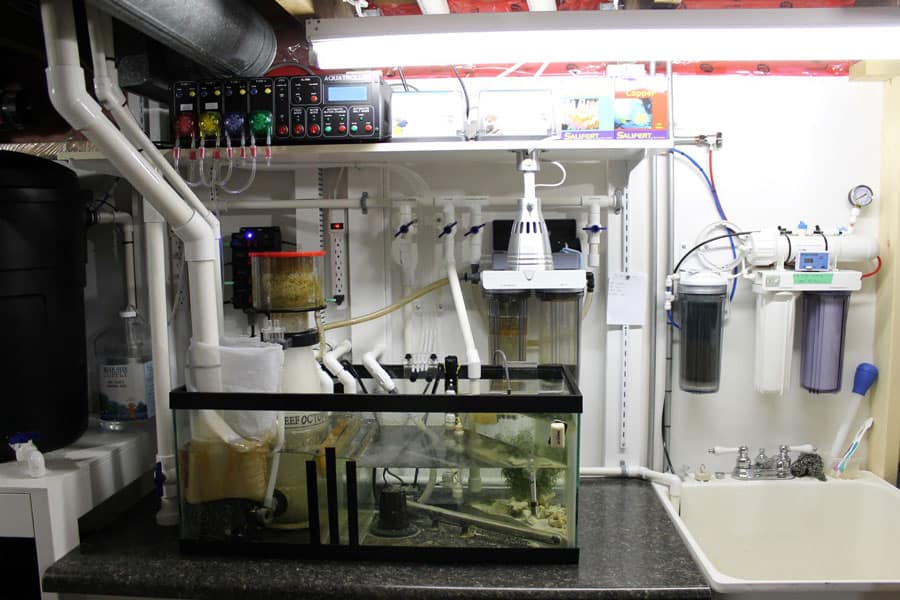
A protein skimmer uses something called ‘Surface Tension‘ to help collect and remove this waste.
Surface Tension, what’s that?
You have all blown bubbles as a kid or with your kids and when you create those bubbles you see an oily, rainbow-colored film on each bubble. That is surface tension sticking the detergent to the outside of the bubble’s surface.
The protein skimmer is a bubble blower on steroids. It sucks in air and water at the bottom and as the bubbles rise through the water inside the device, the waste sticks to the bubbles. The Science why is way beyond what we need to know!
As each bubble rises, it joins with more bubbles to produce foam, that foam then continues to rise up the neck of the protein skimmer until the foam bubbles burst when they reach the lid.
Once the bubble bursts, it drops the hitchhiking waste product which collects in the Removable Collection Cup.
You empty the collection cup that is now full of nothing but organic waste and a little water.
Does a Reef Tank Need A Protein Skimmer?
Short answer, Yes! If you have come to saltwater from the freshwater world you may have never heard of a protein skimmer, but in the saltwater side of the hobby, it is by far one of the most important pieces of equipment needed to ensure your aquarium is healthy and clean.
There are protein skimmers for every type and size of aquarium. Some are excellent and some are terrible. A protein skimmer is a piece of equipment that you do not want to ‘Cheap Out’ on!
What Are The Parts Of A Protein Skimmer?
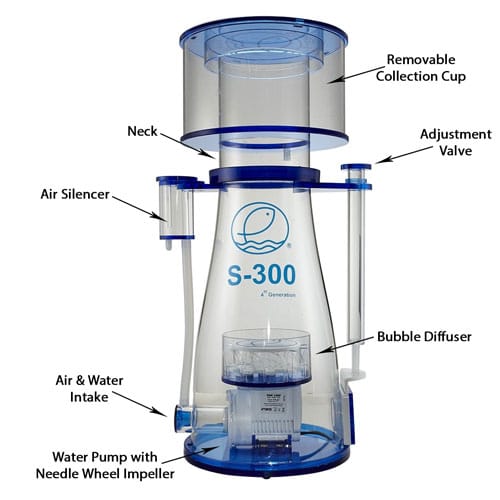
Water Pump with Needle Wheel Impeller:
The main job of the water pump is to suck in water and air from the ‘Air & Water Intake’.
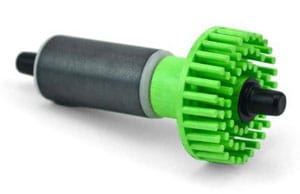
The Needle Wheel Impeller is a specially designed device that breaks up the large bubbles being sucked in and creates millions of tiny bubbles, thus creating more surface area for the waste to stick to.
The more surface area created, the more waste can be collected during the bubble’s journey upwards.
Air & Water Intake:
This is a venturi. A venturi is a pipe that gets smaller in diameter before it gets larger again. Think of an old sand timer lying on its side.
As the pump sucks water through the venturi, the water pressure within the venturi decreases and the speed of the water increases (See Bernoulli’s Principal on Wikipedia). At this point, the air pipe is connected so that the maximum amount of air can be sucked in at the same time.
The water and air mixture is then sucked into the Needle Wheel Impeller before being blown up through the ‘Bubble Diffuser’.
Bubble Diffuser:
The job of this item is to reduce turbulence in the water. Protein skimmers use large water pumps to get the maximum amount of air and water into the skimmer. Because of this, the flow that comes out of them is insane.
The bubble diffuser helps to smooth out the turbulence of the water being blasted out and allows the bubbles to easily rise into the calmer water flow above. If the water is too turbulent, the bubbles will burst as soon as they are formed and not allowed to rise.
Air Silencer:
Ever heard a kid sucking up the last of their milkshake through their straw? This is what you would constantly hear if you didn’t have an air silencer. It is a small device that places a baffle or two inside a small canister to make the sound waves travel around corners. This dampens the noise.
You can still hear a constant sucking noise, but it’s far quieter!
Adjustment Valve:
This opens a valve to let the water out of the protein skimmer body. This valve is used to set how high the water surface gets inside the neck of the skimmer.
The more water you let out of the skimmer, the lower the height will be. The less water you let out of the skimmer, the higher the height will be.
The manufacturer’s instructions will tell you the best height to set the water surface level at inside the neck. On my Reef Octopus NWB150 Protein Skimmer, I have my height set just below where the Collection Cup attaches and I get great, stinky waste collected!
Removable Collection Cup:
It is exactly as is sounds. It’s the part that collects all the waste which you can then remove and throw the gunk down the sink. If the waste stinks your skimmer it doing its job well!
Some collection cups have a small connector on the bottom that allows you to attach a hose and pipe the Collection Cup to a larger container to allow you longer times between emptying.
Are There Different Types Of Protein Skimmer?
Co-Current Design
An older style design of protein skimmer that uses a wooden airstone to create the bubbles and the upward movement of the bubbles pulls in water at the base.
Co-Current means the water and the bubble travel in the same direction. In this case, Upwards.
The water/bubble contact time is not very long and not many bubbles are produced, therefore they are not very efficient and you rarely see them being used today.
They were mainly used on smaller aquariums and were either hung on the side or stuck to the glass like the one shown.
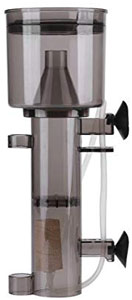
Counter Current Design
Counter-Current, you may have guessed means the water and the bubbles travel in the opposite direction to one another. This aims to provide a longer contact time between the bubbles and the water as the water has to go down and then back up through the bubble stream before exiting the skimmer body.
Again, an old design of skimmer and not used very often. The advent of the ‘Recirculating’ skimmer has really taken over how most protein skimmers are designed today.
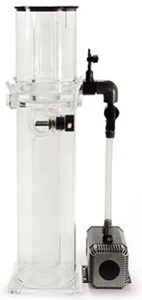
Recirculating Design
This is by far the most popular design in today’s industry.
By using a venturi to suck in the air and water and then send that stream into the skimmer body at an angle, creates a great whirlpool effect under the Bubble Diffuser.
This allows for a huge contact time between the water and bubbles before the bubbles begin to rise through the water column.
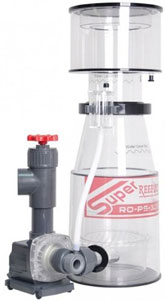
What Are The Most Common Types Of Protein Skimmer?
There are 3 main types of protein skimmer available today to accommodate any sized tank and any type of installation. They are:
- Internal Protein Skimmers
- External Protein Skimmers
- HOB – Hang-On-Back Protein Skimmers
Internal Protein Skimmers
There are by far the most popular and the type that I personally recommend for those who have a sump installed on their tank. The protein skimmer sits in the chamber that the drain from the display tank feeds into.
There are many manufacturers and sizes to suit your needs and it all comes down to personal preference and reviews as to which brand you chose.
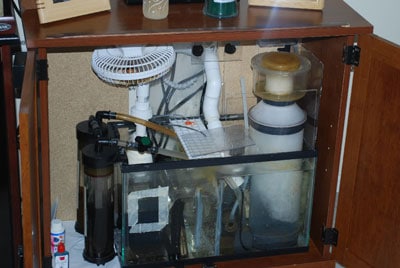
The main reason why I like internal protein skimmers is that from time to time your skimmer will go nuts and overflow your collection cup. Because the protein skimmer is already sitting in the sump, the waste just pours back into the water. No mess created.
External Protein Skimmers
These are skimmers that are mainly aimed at large aquariums or where there is no room to install them in a sump. Many of the external protein skimmers can have several pumps and be of a larger diameter to be able to handle massive volumes of water.
Some of the smaller internal protein skimmers can also be plumbed to be used externally when space is at a premium.
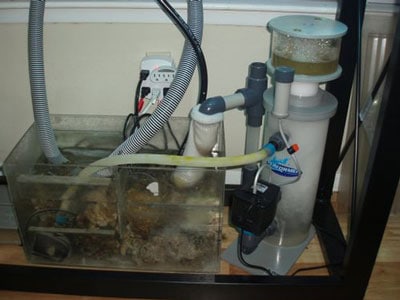
These are a great alternative but you must keep an eye on the collection cup. If it overflows the waste can really stink for a long time if it gets in the wrong place. Have you ever spilled milk in a car and then summer comes along?!
HOB – Hang-On-Back Protein Skimmers
These are purposely designed for aquariums that do not have a sump. They are usually made of a flat style box so they can be discretely hung on the back of the aquarium and be hidden. A HOB skimmer uses the Co-Current method of water/bubble interfacing.
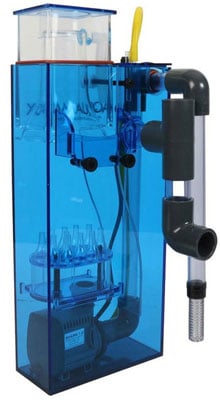
The pump will suck up water from the aquarium, mix it with the air and the collection cup collects the junk, just like the other skimmers. They are mainly used for aquariums up to 100 gallons but due to their size and shape, they are not as efficient as the Recirculating Protein Skimmers.
As with all the other skimmers, there are many to chose from depending on your aquarium size and bioload so no matter what your system, you should be able to find a HOB skimmer to fit.
How Do You Size A Protein Skimmer To An Aquarium?
Remember the protein skimmer mainly removes Dissolved Organic Compounds. These are produced by the bioload (Biological Load) of your aquarium.
How many fish do you have? How large are those fish, How much do they poop? (Watch your Tang take a dump!), How much food do you feed? How much Clean-Up-Crew do you have? Do you vacuum your sand bed? Do you turkey baste your rocks? Do you have strong, irregular water flow? How many fish are you wanting to end up with? What size will these fish grow to?
The more of these answers you have, the higher the bioload in your aquarium and the bigger the skimmer will need to be to handle all of this waste.
There are two general rules of thumb:
- Pick a skimmer that is rated for around the total system volume (Aquarium, Sump, Frag Tank etc) and bioload.
- To match the air input of the skimmer to the system volume. eg: if the skimmer is rated at 400l/hr (100GPH) of air it will be suited for aquariums in the 90-100 gallon range.
Most protein skimmer manufacturers will show each skimmers recommended aquarium size and sometimes a bioload rating to help you decide.
My aquarium is 75 gallons, my sump is 20 gallons and my frag tank is 8 gallons. Once you take out the displacement for rock and water height in my sump, my total system volume is around 90 gallons.
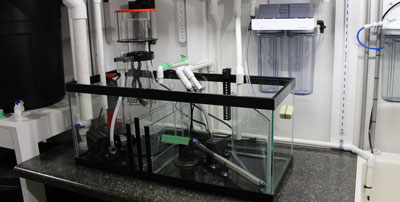
The Protein Skimmer I selected was the Reef Octopus NWB 150. Its a great skimmer rated for 150 gallons, great reviews, great price, and my bioload is relatively low. This made it a perfect fit for my system.
Be careful not to pick a skimmer that is too big otherwise it may not pull out any waste from your water and you will have paid more than what you need.
Your skimmer needs to have a consistent source of dissolved organics to allow the bubbles to stick together and produce the foam. If the skimmer is too large and it strips the water of its organics, no foam will produce and it must wait until more dissolved organics are formed before it can begin removing them.
This ends up in a skimmer that is in a kind of ‘On/Off’ state which leads to inconsistent water parameters.
By reading the reviews of fellow protein skimmer owners you can pick one to suit your system very easily.
To see many different types of Protein Skimmer please take a look at the vast range HERE at Amazon.com. They have every kind of Protein Skimmer to suit any installation.
How Do You Set up A Protein Skimmer?
There are two main elements you need to address to ensure your protein skimmer will work efficiently:
- Surrounding Water Height if your skimmer is an Internal Type
- Water/Bubble Surface Height set correctly
Surrounding Water Height
If your skimmer is an internal type then the manufacturer will show you the height at which the surrounding water must sit. In other words, how high must the skimmer body stick out the top of the water in the sump. This is to ensure it works at its optimum designed performance.
There are 3 ways to achieve a set water height around your skimmer:
1. Sit your protein skimmer on a stand or blocks to raise it to the correct height.
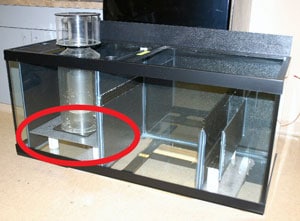
2. Install a glass baffle in your sump to act as a dam and fill the water in that compartment to the correct height.
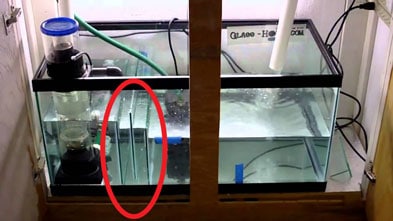
3. Install your Automatic Top-Off System to keep your sump water level at the correct height.
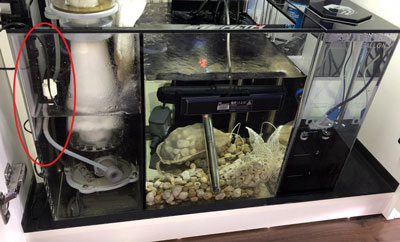
To read more about Automatic Top Off Systems check out my article Here…
Water/Bubble Surface Height
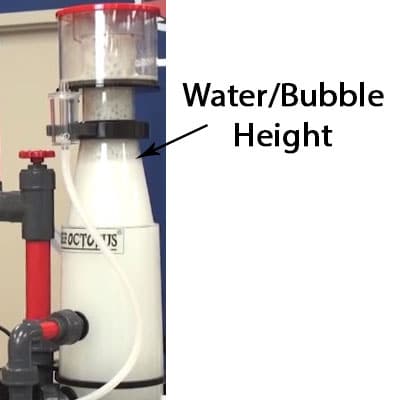
Each protein skimmer will also come with instructions on how to set the Adjustment Valve to get the water/bubble height just right. It may take a little bit of playing but its usually somewhere in the neck of the skimmer.
Setting the height higher will mean the bubbles will be wetter when they burst, meaning you will be skimming ‘Wet’ or if you set the height lower the bubbles will be a little drier and when they burst there will be less liquid content and thus you will be skimming ‘Dry’.
What Is Wet Or Dry Protein Skimming?
Wet Skimming is when there is a little more liquid and less waste in the collection cup. It produces Skimmate (Name given to the collected waste) faster, but it’s less concentrated.
Be aware that if you are skimming wet and you are pulling out lots of liquid on a small tank, your Automatic Top Off will be replacing this with just fresh water. Your salinity will slowly start to drop if not taken care of!
Dry Skimming is when there is less liquid but more waste in the collection cup. It produces Skimmate slower, but it is more concentrated.
Most people tend to set their skimmer on the slightly drier side so that the Skimmate is a rich yellow/brown, stinky consistency.
What Is A Protein Skimmer Break-In Period?
Every protein skimmer will have what is known as a ‘Break-In’ Period. When a protein skimmer is molded during manufacture, the machines coat the molding tools in oil to prevent the plastic from sticking to the mold.
It can take anywhere from a few days to a few weeks for this oil to break down and be removed from your water system. Cleaning the skimmer before use is always recommended, but there will be places you cannot reach.
During this break-in period, you may have to adjust the valve daily to keep the water/bubble surface at the correct height, but once it is ‘Settled In’ you will hardly have to touch the Adjustment Valve.
How Do You Maintain A Protein Skimmer?
As with everything in this hobby you need to keep things clean to keep them working at their best. Here are a few things you need to do to ensure your gunk keeps getting removed:
- Empty & clean your collection cup frequently. You don’t want the waste the skimmer has just removed overflowing back into the water!
- Clean the neck of the skimmer and the collection cup weekly to keep the sides smooth. Rough sides cause the bubbles to burst prematurely. I use a toothbrush and rinse the cup under the tap.
- Keep the air intake free from salt creep. A blocked intake will raise the water/bubble height and produce fewer bubbles.
- Remove and clean all your pump and Needle-Wheel Impeller every month or two.
- Every year completely remove your skimmer and run it in a bucket of warm water and white vinegar to help remove baked-on coralline and crustaceans. Rinse well and put back into your aquarium system.
Common Protein Skimmer Questions:
Do I run my protein skimmer during the tank cycle?
Yes, you need to let the protein skimmer Break-In and allow your tank to adjust to all its equipment and find its natural balance. As your bacteria build during the cycle, all the factors affecting your tank will determine its natural parameters. If you then turn on an item like a protein skimmer, your tank will have a tiny re-cycle as it now adjusts to the change in the eco-system. Run everything on your tank during its cycle as you would run it normally. Light Schedule, all equipment, everything. The only thing you do not do is a water change.
Why does the skimmer keep overflowing?
This could be caused by a brand new protein skimmer that needs to Break In. Just adjust the valve as low as it goes, let it run and overflow, it will settle down in a day or two.
A blocked air intake
A medication introduced to the water (Chemiclean for treatment of Cyano Algae always sends your skimmer nuts)
A wandering fish found its way into the sump and got sucked into the pump intake
A family member spraying air freshener in the room
Scented Candles burning
Sometimes you can adjust the skimmer valve down to drop the water/bubble level for a few hours/days or turn off the skimmer for a few hours and try again.
Why does my protein skimmer not produce any foam?
Your skimmer could be in it’s Break-In period and just needs a little more time.
Ensure your entire air line, silencer and venturi are not blocked
There is not enough bioload in your system yet and there is not enough dissolved organics to produce a good amount of foam.
If you would like some more information on the Aquarium Cycle, Sumps or Automatic Top-Off Systems be sure to check out my articles on them:

